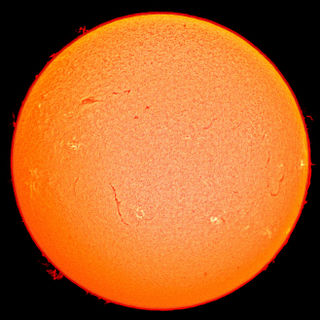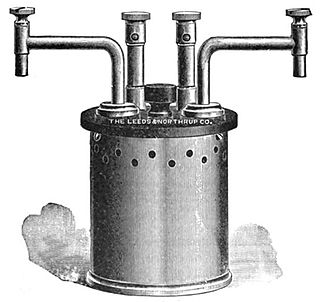| Look up joule or joules in Wiktionary, the free dictionary. |
The joule (symbol: J) is the SI derived unit of energy
Contents
Joule or joules may also refer to:
| Look up joule or joules in Wiktionary, the free dictionary. |
The joule (symbol: J) is the SI derived unit of energy
Joule or joules may also refer to:

The calorie is a unit of energy defined as the amount of heat needed to raise the temperature of a quantity of water by one degree Celsius.

In physics, energy is the quantitative property that must be transferred to a body or physical system to perform work on the body, or to heat it. Energy is a conserved quantity; the law of conservation of energy states that energy can be converted in form, but not created or destroyed. The unit of measurement in the International System of Units (SI) of energy is the joule, which is the energy transferred to an object by the work of moving it a distance of one metre against a force of one newton.

Entropy is a scientific concept as well as a measurable physical property that is most commonly associated with a state of disorder, randomness, or uncertainty. The term and the concept are used in diverse fields, from classical thermodynamics, where it was first recognized, to the microscopic description of nature in statistical physics, and to the principles of information theory. It has found far-ranging applications in chemistry and physics, in biological systems and their relation to life, in cosmology, economics, sociology, weather science, climate change, and information systems including the transmission of information in telecommunication.

Enthalpy, a property of a thermodynamic system, is the sum of the system's internal energy and the product of its pressure and volume. It is a state function used in many measurements in chemical, biological, and physical systems at a constant pressure, which is conveniently provided by the large ambient atmosphere. The pressure–volume term expresses the work required to establish the system's physical dimensions, i.e. to make room for it by displacing its surroundings. The pressure-volume term is very small for solids and liquids at common conditions, and fairly small for gases. Therefore, enthalpy is a stand-in for energy in chemical systems; bond, lattice, solvation and other "energies" in chemistry are actually enthalpy differences. As a state function, enthalpy depends only on the final configuration of internal energy, pressure, and volume, not on the path taken to achieve it.

The hertz (symbol: Hz) is the derived unit of frequency in the International System of Units (SI) and is defined as one cycle per second. It is named after Heinrich Rudolf Hertz (1857–1894), the first person to provide conclusive proof of the existence of electromagnetic waves. Hertz are commonly expressed in multiples: kilohertz (103 Hz, kHz), megahertz (106 Hz, MHz), gigahertz (109 Hz, GHz), terahertz (1012 Hz, THz), petahertz (1015 Hz, PHz), exahertz (1018 Hz, EHz), and zettahertz (1021 Hz, ZHz).
The joule is a derived unit of energy in the International System of Units. It is equal to the energy transferred to an object when a force of one newton acts on that object in the direction of the force's motion through a distance of one metre. It is also the energy dissipated as heat when an electric current of one ampere passes through a resistance of one ohm for one second. It is named after the English physicist James Prescott Joule (1818–1889).

Thermodynamic temperature is a quantity defined in thermodynamics as distinct from kinetic theory or statistical mechanics. A thermodynamic temperature reading of zero is of particular importance for the third law of thermodynamics. By courtesy, it reported on the Kelvin scale of temperature in which the unit of measure is the kelvin. For comparison, a temperature of 295 K is equal to 21.85 °C and 71.33 °F.
The joule per mole is an SI derived unit of energy per amount of material. Energy is measured in joules, and the amount of material is measured in moles. For example, Gibbs free energy is quantified as joules per mole. It is also a SI derived unit of molar thermodynamic energy defined as the energy equal to one joule in one mole of substance.

James Prescott Joule was an English physicist, mathematician and brewer, born in Salford, Lancashire. Joule studied the nature of heat, and discovered its relationship to mechanical work. This led to the law of conservation of energy, which in turn led to the development of the first law of thermodynamics. The SI derived unit of energy, the joule, is named after him.
In thermodynamics, the Joule–Thomson effect describes the temperature change of a real gas or liquid when it is forced through a valve or porous plug while keeping it insulated so that no heat is exchanged with the environment. This procedure is called a throttling process or Joule–Thomson process. At room temperature, all gases except hydrogen, helium, and neon cool upon expansion by the Joule–Thomson process when being throttled through an orifice; these three gases experience the same effect but only at lower temperatures. Most liquids such as hydraulic oils will be warmed by the Joule–Thomson throttling process.
Sensible heat is heat exchanged by a body or thermodynamic system in which the exchange of heat changes the temperature of the body or system, and some macroscopic variables of the body or system, but leaves unchanged certain other macroscopic variables of the body or system, such as volume or pressure.

Latent heat is energy released or absorbed, by a body or a thermodynamic system, during a constant-temperature process — usually a first-order phase transition.

The newton-metre is a unit of torque in the SI system. One newton-metre is equal to the torque resulting from a force of one newton applied perpendicularly to the end of a moment arm that is one metre long. The nonstandard notation Nm occurs in some fields.

In thermodynamics, the Gibbs free energy is a thermodynamic potential that can be used to calculate the maximum reversible work that may be performed by a thermodynamic system at a constant temperature and pressure. The Gibbs free energy (, measured in joules in SI) is the maximum amount of non-expansion work that can be extracted from a thermodynamically closed system. This maximum can be attained only in a completely reversible process. When a system transforms reversibly from an initial state to a final state, the decrease in Gibbs free energy equals the work done by the system to its surroundings, minus the work of the pressure forces.

The term 'thermal energy' is used differently, and often loosely, in different contexts. It refers to several distinct physical concepts, such as the internal energy, or as the enthalpy, of a body of matter and radiation; or as heat, defined as a type of energy transfer ; or as the characteristic energy of a degree of freedom, , in a system that is described in terms of its microscopic particulate constituents, where denotes temperature and denotes the Boltzmann constant.

Joule heating, also known as resistive, resistance, or Ohmic heating, is the process by which the passage of an electric current through a conductor produces heat.
The joule-second is the product of an SI derived unit, the joule (J), and an SI base unit, the second (s). The joule-second is a unit of action or of angular momentum. The joule-second also appears in quantum mechanics within the definition of Planck's constant. Angular momentum is the product of an object’s moment of inertia, in units of kg⋅m2 and its angular velocity in units of rad⋅s−1. This product of moment of inertia and angular velocity yields kg⋅m2⋅s−1 or the joule-second. Planck's constant represents the energy of a wave, in units of joule, divided by the frequency of that wave, in units of s−1. This quotient of energy and frequency also yields the joule-second (J⋅s).

In thermodynamics, work performed by a system is energy transferred by the system to its surroundings, by a mechanism through which the system can spontaneously exert macroscopic forces on its surroundings. In the surroundings, through suitable passive linkages, the work can lift a weight, for example. Energy can also transfer from the surroundings to the system; in a sign convention used in physics, such work has a negative magnitude.

The ohm is the SI derived unit of electrical resistance, named after German physicist Georg Ohm. Various empirically derived standard units for electrical resistance were developed in connection with early telegraphy practice, and the British Association for the Advancement of Science proposed a unit derived from existing units of mass, length and time, and of a convenient scale for practical work as early as 1861. As of 2020, the definition of the ohm is expressed in terms of the quantum Hall effect.

In thermodynamics, heat is energy in transfer to or from a thermodynamic system, by mechanisms other than thermodynamic work or transfer of matter. The various mechanisms of energy transfer that define heat are stated in the next section of this article.